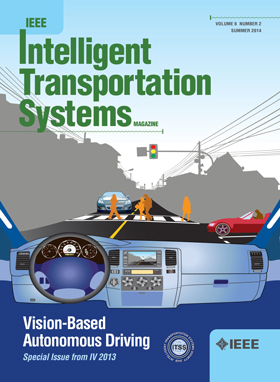Exploring Spatio-Temporal Carbon Emission Across Passenger Car Trajectory Data
IF 7.9
1区 工程技术
Q1 ENGINEERING, CIVIL
IEEE Transactions on Intelligent Transportation Systems
Pub Date : 2024-12-30
DOI:10.1109/TITS.2024.3509381
引用次数: 0
Abstract
Carbon emissions caused by passenger cars in cities are essentially responsible for severe climate change and serious environmental problems. Exploring carbon emissions from passenger cars helps to control urban pollution and achieve urban sustainability. However, it is a challenging task to foresee the spatio-temporal distribution of carbon emission from passenger cars, as the following technical issues remain. i) Vehicle carbon emissions contain complex spatial interactions and temporal dynamics. How to collaboratively integrate such spatial-temporal correlations for carbon emission prediction is not yet resolved. ii) Given the mobility of passenger cars, the hidden dependencies inherent in traffic density are not properly addressed in predicting carbon emissions from passenger cars. To tackle these issues, we propose a Collaborative Spatial-temporal Network (CSTNet) for implementing carbon emissions prediction by using passenger car trajectory data. Within the proposed method, we devote to extract collaborative properties that stem from a multi-view graph structure together with parallel input of carbon emission and traffic density. Then, we design a spatial-temporal convolutional block for both carbon emission and traffic density, which constitutes of temporal gate convolution, spatial convolution and temporal attention mechanism. Following that, an interaction layer between carbon emission and traffic density is proposed to handle their internal dependencies, and further model spatial relationships between the features. Besides, we identify several global factors and embed them for final prediction with a collaborative fusion. Experimental results on the real-world passenger car trajectory dataset demonstrate that the proposed method outperforms the baselines with a roughly 7%-11% improvement.探索乘用车轨迹数据中的时空碳排放量
本文章由计算机程序翻译,如有差异,请以英文原文为准。
求助全文
约1分钟内获得全文
求助全文
来源期刊

IEEE Transactions on Intelligent Transportation Systems
工程技术-工程:电子与电气
CiteScore
14.80
自引率
12.90%
发文量
1872
审稿时长
7.5 months
期刊介绍:
The theoretical, experimental and operational aspects of electrical and electronics engineering and information technologies as applied to Intelligent Transportation Systems (ITS). Intelligent Transportation Systems are defined as those systems utilizing synergistic technologies and systems engineering concepts to develop and improve transportation systems of all kinds. The scope of this interdisciplinary activity includes the promotion, consolidation and coordination of ITS technical activities among IEEE entities, and providing a focus for cooperative activities, both internally and externally.
 求助内容:
求助内容: 应助结果提醒方式:
应助结果提醒方式:


